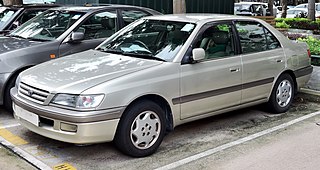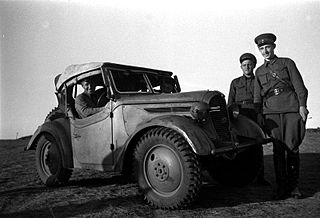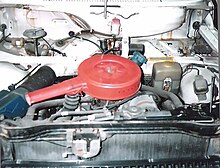
The Subaru Impreza is a compact car that has been manufactured by the Japanese automaker Subaru since 1992. It was introduced as a replacement for the Leone, with the predecessor's EA series engines replaced by the new EJ series. It is now in its sixth generation.

The Subaru Rex, also known as Ace, Viki, Sherpa, 500/600/700, Mini Jumbo, Mini Subaru or M60/M70/M80 in various export markets, is a kei class automobile produced from 1972 to 1992 mainly for sale in Japan by Subaru, although it was also sold in Europe, South America, Australia and the Caribbean. The Rex superseded the R-2 as Subaru's kei car, and has been available in commercial use versions as well as in a passenger car version. It underwent major changes in 1976, in fall 1981, and again in late 1986. The second generation Rex (1981–1986) also formed the basis for the larger Subaru Justy.

The Buick Skyhawk is an automobile produced by Buick in two generations for the 1975 through 1989 model years.

The Toyota Corona is an automobile manufactured by the Japanese automaker Toyota across eleven generations between 1957 and 2001. On launch, the Corona was Toyota's next to highest product in their range, just below the Crown. The Corona was marketed in the JDM at Toyota's Toyopet Store dealership channels, and the Corona was one of Toyota's first models exported to other global markets, followed by the smaller Toyota Corolla.

The Subaru Leone is a compact car produced by the Japanese car manufacturer Subaru from 1971 to 1994. The word leone is Italian for lion.

The Subaru Justy is a subcompact hatchback that has been sold by Japanese automobile manufacturer Subaru since 1984. Subaru manufactured the Justy from 1984 to 1994; since then it has sold rebadged versions of other vehicles under the Justy nameplate. The company introduced the latest iteration, a rebadged Daihatsu Boon, at the 2007 Frankfurt Motor Show with a 1.0 or 1.2-liter straight-three engine, front/four wheel drive, electronically controlled continuously variable transaxle, or a 5-speed manual transaxle. For the 2010 model year, the Justy was replaced with the Subaru Trezia. The Justy nameplate was revived in November 2016 as a rebadged Toyota Tank and its twin counterpart the Toyota Roomy and Daihatsu Thor.

The Subaru FF-1 G was a compact car from the 1970s, replacing the FF-1 Star. It was a front-wheel drive vehicle with a typical Subaru EA61 or EA62 flat-4 engine. The car also had independent torsion bar suspension and rack and pinion steering, inboard front drum brakes and dual radiators. The car used only a small radiator on starting, hastening warm up. Achieving 29 miles per US gallon, the Subaru quickly became a strong-selling import car in the United States.

The Subaru XT was a four-passenger, 2-door coupé manufactured and marketed by Subaru for model years 1985-1991, with a facelift in 1987. Assembly took place at Subaru's Yajima Plant in Ota, Japan and during its single generation, production reached just over 98,000.

The Nissan AD is a subcompact van and wagon built by Nissan since 1982. The AD is sold under a different name when manufactured as a passenger car, called the Nissan Wingroad.

The Toyota Carina is an automobile which was manufactured by Toyota from December 1970 to December 2001. It was introduced as a sedan counterpart of the Celica, with which it originally shared a platform. Later, it was realigned to the Corona platform, but retained its performance image, with distinctive bodywork and interior — aimed at the youth market and remaining exclusive to Japanese Toyota dealerships Toyota Store. It was replaced in Japan by the Toyota Allion in 2001 and succeeded in Europe by the Toyota Avensis.

The Lancia Rally was a mid-engine sports car and rally car built by Lancia in the early 1980s to compete in the FIA Group B World Rally Championship. Driven by Markku Alén, Attilio Bettega, and Walter Röhrl, the car won Lancia the manufacturers' world championship in the 1983 season. It was the last rear-wheel drive car to win the WRC.

The Type 95 was a Japanese scout car built by Tokyu Kurogane Industries, and was used during the war with China and World War II in the East. Between 1936 and 1944 approximately 4,700 were built. It was the only completely Japanese designed reconnaissance car ever used by the Imperial Japanese Army, which tended to use civilian cars. Its nickname is the "Yonki" (よんき) which in Japanese means "all-wheel drive". In the field, soldiers often called it the "daruma" after the Buddhist symbol for good luck.

The Subaru EA engine is a series of automobile internal combustion engines manufactured by Subaru, a division of Fuji Heavy Industries. All EA series engines are of a flat-4 design, and have always been water cooled.

The Subaru Sambar is a cabover truck and microvan manufactured and marketed by Subaru as Japan's first truck compliant with the country's strict Keitora (軽トラ) or Kei vehicle tax class. Introduced in 1961 in microvan and Kei pickup configurations, the Sambar remains in production, now in its eighth generation — beginning with the sixth generation as a rebadged Daihatsu Hijet.

The Subaru 1500 is the first car built by Fuji Heavy Industries, with the development code-name of P1. The prototype used a monocoque body structure and adopting the "ponton" style appearance, with an independent front wishbone suspension and a rear leaf spring suspension with three plates and a live rear axle.

The first generation Subaru Legacy is a mid-size family car / wagon developed by Fuji Heavy Industries. The Legacy was an all new model, and was considered a notable departure from Subaru products in the past.

The second-generation Subaru Legacy was marketed in Japan from October 1993, and July 1994 marked the second generation in North America with a full body and chassis revision. The exterior was designed by Olivier Boulay in 1991, during his tenure at Subaru. The tail light appearance on both the sedan and wagon was influenced by the taillights on the SVX.

Subaru launched the third generation Japanese and world-market Legacy in June 1998, while the North American model was introduced in May 1999 for the 2000 model year. In all markets except for the United States, production lasted through 2002, with a limited production Blitzen model sold mid-cycle under the 2003 model year in Japan. Production in the United States lasted through 2004.

The second generation of the Subaru Impreza compact car was introduced in 2000 and manufactured up to 2007 by Subaru in Ota, Gunma, Japan, in both sedan and five-door wagon bodystyles, as well as two intermediate facelifts throughout its lifespan.


























